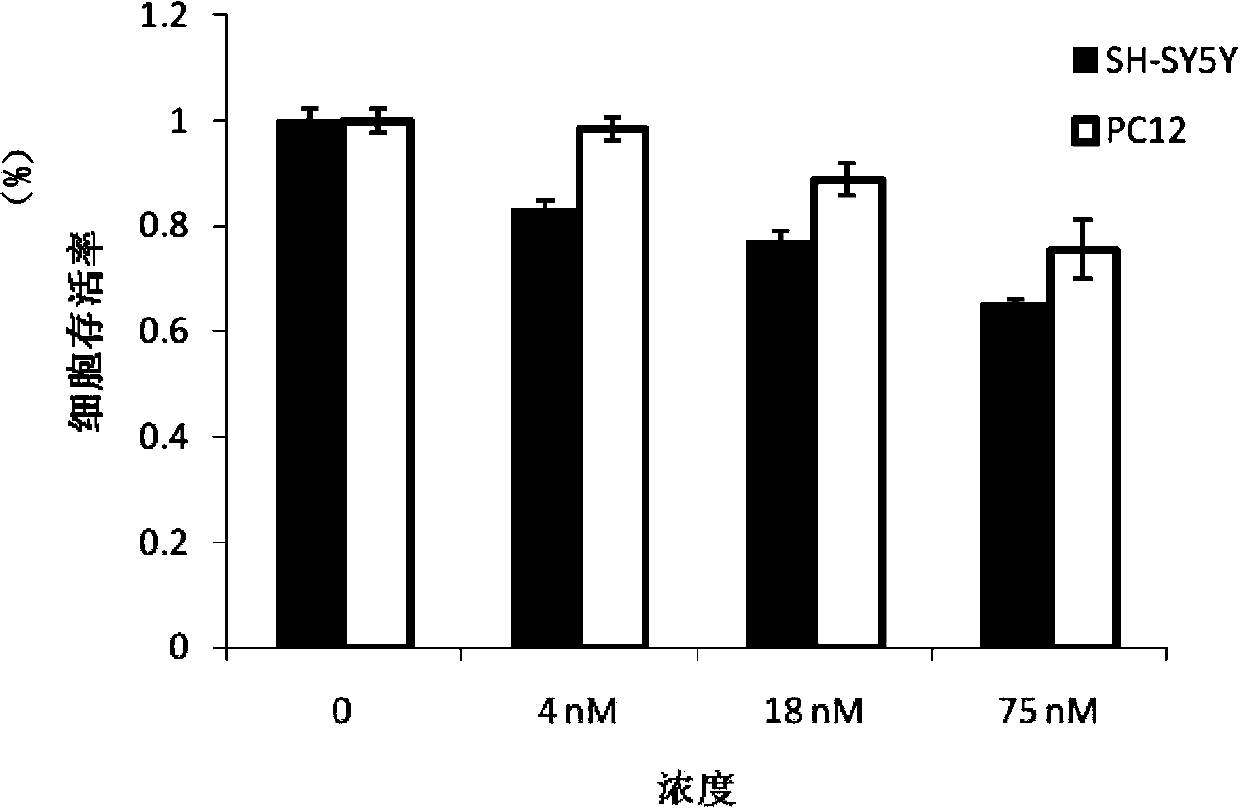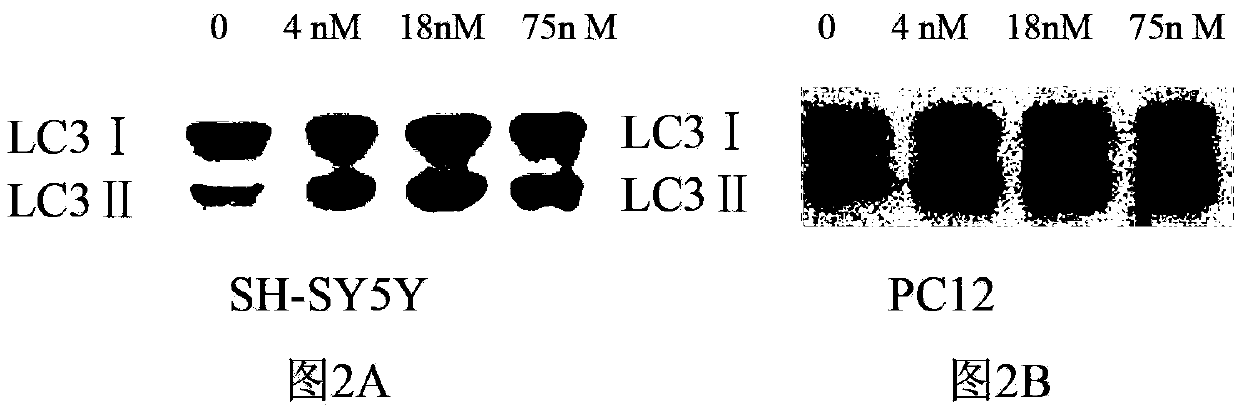Method for eliminating alpha-synuclein generated in Parkinson's model cells by using cadmium telluride quantum dots and application thereof
A technology of cadmium telluride quantum dots and nuclear synapse proteins, applied in animal cells, tumor/cancer cells, vertebrate cells, etc.
- Summary
- Abstract
- Description
- Claims
- Application Information
AI Technical Summary
Problems solved by technology
Method used
Image
Examples
Embodiment 1
[0023] Example 1 Preparation of water-soluble cadmium telluride quantum dots (prepared with reference to CN1693206A)
[0024] 1) Preparation of potassium hydride telluride: 110.5 mg KBH 4 Put the solid and 91.6 mg of tellurium powder into a flask, add 3 milliliters of water, and react at 0 degrees Celsius for 20 hours to obtain a KHTe solution for subsequent use;
[0025] 2) Preparation of cadmium telluride precursor solution: 36.8 mg of CdCl 2 Dissolve in 100 ml of water, add 0.05 ml of mercaptoacetic acid, adjust pH=11.0 with 0.5 mol / L NaOH solution to obtain cadmium telluride precursor solution, pass nitrogen to remove oxygen, and store under nitrogen protection;
[0026] 3) Preparation of CdTe quantum dots by program-controlled microwave irradiation: the prepared cadmium telluride precursor solution was subjected to program-controlled microwave heating to obtain water-soluble cadmium telluride quantum dots. The microwave heating conditions are as follows: the microwave p...
Embodiment 2
[0028] Example 2 Detection of biocompatibility of cadmium telluride quantum dots using thiazole blue method
[0029] Experimental method: Thiazolium blue method (MTT) is a method to detect cell survival and growth. The detection principle is that succinate dehydrogenase in the mitochondria of living cells can reduce exogenous thiazolyl blue to water-insoluble blue-purple crystalline formazan and deposit in the cells, while dead cells have no such function. Sodium dodecyl sulfate at pH 2.5 can dissolve formazan in cells, and its light absorption value is measured at a wavelength of 490nm with an enzyme-linked immunosorbent detector, which can indirectly reflect the activity of living cells.
[0030] The detection process includes the following steps:
[0031] 1) Cell culture: SH-SY5Y cells (derived from human dopaminergic neuroblastoma cell line, purchased from the Cell Bank of the Chinese Academy of Sciences) or PC12 cells (derived from rat adrenal medulla pheochromocytoma, p...
Embodiment 3
[0038] Example 3 Detection of whether autophagy occurs in cells
[0039] Experimental method: When cells undergo autophagy, LC3Ⅰ protein with a molecular weight of 18Kd in the cytoplasm combines with phosphatidylethanolamine on the surface of the autophagic vesicle membrane to form 16Kd LC3Ⅱ, which is located in the autophagosome membrane. The ratio of LC3II to LC3I protein content reflects the autophagy activity of cells. The present invention uses Western blot method to detect the value of LC3II / LC3I so as to detect the influence of quantum dots on cell autophagy.
[0040] The detection process includes the following steps:
[0041] 1) Cell culture: place SH-SY5Y or PC12 cells at 37°C with 5% CO 2 Culture in the DMEM medium that contains the fetal calf serum of volume fraction 10% and 1% penicillin streptomycin in the incubator;
[0042] 2) Cell plating: Digest the cell suspension after the cells are full, and count the cells at 3×10 cells per well. 5 Cells were plated in...
PUM
| Property | Measurement | Unit |
|---|---|---|
| particle diameter | aaaaa | aaaaa |
Abstract
Description
Claims
Application Information
 Login to View More
Login to View More - R&D
- Intellectual Property
- Life Sciences
- Materials
- Tech Scout
- Unparalleled Data Quality
- Higher Quality Content
- 60% Fewer Hallucinations
Browse by: Latest US Patents, China's latest patents, Technical Efficacy Thesaurus, Application Domain, Technology Topic, Popular Technical Reports.
© 2025 PatSnap. All rights reserved.Legal|Privacy policy|Modern Slavery Act Transparency Statement|Sitemap|About US| Contact US: help@patsnap.com



